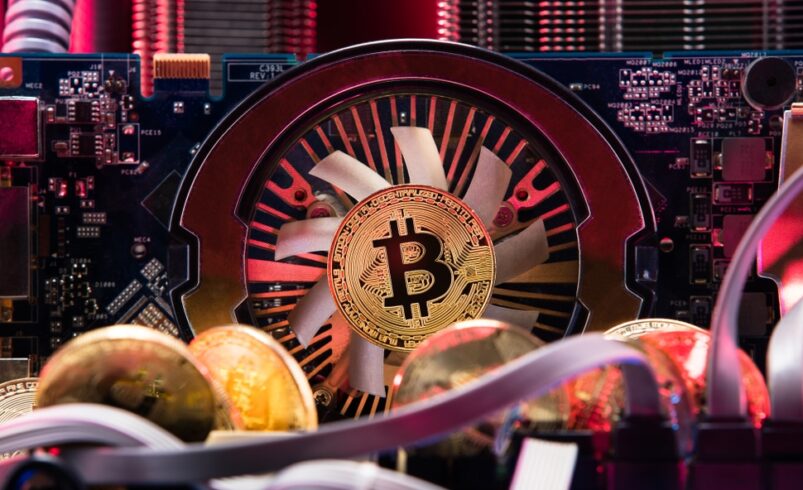What is Bitcoin Mining? A Comprehensive Guide to Understanding the Process

Bitcoin is frequently likened to “Digital Gold” due to its role as a value reserve. Just as gold is extracted from the ground, Bitcoin must be mined to introduce new coins into circulation. While gold extraction requires physical labor, the process of obtaining cryptocurrencies involves solving digital challenges using specific software.
Is it possible to mine Bitcoins? And if so, how can one mine Bitcoins from one’s residence? This guide delves deep into the concept of mining and the methods to mine Bitcoin domestically.
Mining Bitcoin demands significant computational strength and resources. If you wish to mine Bitcoins independently, specialized hardware like ASICs is essential. Alternatively, instead of establishing and overseeing the equipment, you can lease resources from a cloud-based mining service.
What Exactly is Bitcoin Mining?
Bitcoin, the pioneering digital currency, operates on a public record known as the blockchain. Bitcoin mining refers to the act of authenticating transactions, appending new blocks to the record, and producing new Bitcoins. In return for their services in validating transactions and safeguarding the network’s integrity, miners receive new Bitcoins.
How is Bitcoin Mined?
Here’s a straightforward breakdown of the Bitcoin mining procedure:
- Transactions – Every Bitcoin transaction is documented on the blockchain. A set of authenticated transactions is consolidated into a block. This block retains transaction data, timestamps, and the hash/code of its preceding block to preserve the sequence.
- Block Formation – Miners gather pending transactions and vie to resolve intricate mathematical challenges. This task is demanding and necessitates substantial computational capacity. Miners persistently seek the hash/key for the subsequent block that aligns with specific set standards. Upon discovering the next block’s hash, they incorporate it into the blockchain.
- Block Verification – Once a miner deciphers the challenges and identifies a solution, they broadcast it across the network. Other miners then assess its adherence to set standards and the validity of its transactions. Upon unanimous agreement on the block’s legitimacy, it’s integrated into the network, becoming an immutable segment of the chain.
- Block Incentive – The initial miner to unravel the challenge and identify the block receives newly created Bitcoins. Every four years, the Bitcoin block incentive is halved, as per its inherent stipulations. Miners also earn fees for transaction validation.
- Difficulty Modulation – Roughly every two weeks, the Bitcoin network recalibrates its mining difficulty. This ensures a steady pace of block addition to the network, approximately every 10 minutes. This adjustment occurs irrespective of the computational power fluctuations in mining.
Understanding Bitcoin Mining at Home
While Bitcoin mining was notably more lucrative during its early years, such as 2009 and 2010, its profitability has waned due to rising mining challenges, electricity, and upkeep expenses. However, if one can secure affordable electricity and a consistent internet connection, mining can still be beneficial. Here’s a guide on how to undertake Bitcoin mining from the comfort of your home.
Establishing a Mining Setup
To begin, it’s essential to acquire and establish a piece of hardware known as a mining rig for Bitcoin mining. Given the intensive computational demands of mining, consider ASIC (Application Specific Integrated Circuit) miners. These are advanced versions of traditional mining rigs tailored to manage intricate calculations.
Creating a Bitcoin Wallet
Upon successfully deciphering intricate problems and mining Bitcoins, you’ll need a mechanism to collect them. Hence, possessing a Bitcoin wallet is crucial for receiving and safeguarding your Bitcoin earnings. For long-term storage, consider using a reputable cold crypto wallet. However, if easy access is a priority, opt for a leading hot crypto wallet. It’s advisable to maintain a separate wallet exclusively for mining.
Installing Bitcoin Mining Software
The subsequent step involves downloading and setting up Bitcoin mining software. This phase demands some technical understanding, so it’s vital to familiarize yourself with various software options and select one that aligns with your objectives. Notable Bitcoin mining software includes EasyMiner, CGMiner, and BFGMiner.
Participating in a Mining Pool
Choosing between joining a mining pool or mining independently is a personal decision. However, with the escalating mining challenges, pooling resources with other miners is often the more pragmatic choice. In such pools, miners amalgamate their computational strength, enhancing the likelihood of identifying the next block. Rewards are then allocated based on individual contributions. Renowned crypto mining pools include BTC.com, Slush Pool, and Antpool.
Once you’ve aligned with a mining pool, you can commence with solving mathematical problems to mine Bitcoins. It’s worth noting that home-based Bitcoin mining demands a degree of technical proficiency, especially concerning equipment setup and maintenance.
Furthermore, as mining becomes progressively challenging, solo miners might find it tough to vie against larger mining collectives.
Cloud Mining: An Alternate Bitcoin Mining Method
For those opposed to the intricacies of hardware and software setup and the associated costs, cloud mining presents a viable alternative. This approach involves leasing computational capacity from a dedicated cloud mining service.
After selecting a trustworthy cloud mining platform and registering, familiarize yourself with its offerings and select a mining package that resonates with your needs. As you’re renting computational prowess, there’s a fee involved. Once you’ve procured a mining contract, you can begin mining Bitcoins, capitalizing on sophisticated cloud mining techniques. Service providers, such as Shamining and LetMeCloud, manage the equipment’s setup, upkeep, and operational expenses, allowing users to mine without engaging with specialized hardware.
Final Thoughts
The trajectory of mining is contingent on various elements, including Bitcoin’s price fluctuations, technological advancements in mining, decentralization efforts, block incentives, and transaction charges. Energy utilization and ecological considerations also play pivotal roles in determining the viability of Bitcoin mining.
Given the volatile nature of the market, it’s challenging to predict the future profitability of mining. The cryptocurrency domain has witnessed significant evolution, and the mining sector will undoubtedly adapt to these shifts.
DISCLAIMER: It's essential to understand that the content on this page is not meant to serve as, nor should it be construed as, advice in legal, tax, investment, financial, or any other professional context. You should only invest an amount that you are prepared to lose, and it's advisable to consult with an independent financial expert if you're uncertain. For additional details, please review the terms of service, as well as the help and support sections offered by the provider or promoter. While our website strives for precise and impartial journalism, please be aware that market conditions can shift unexpectedly and some (not all) of the posts on this website are paid or sponsored posts.









